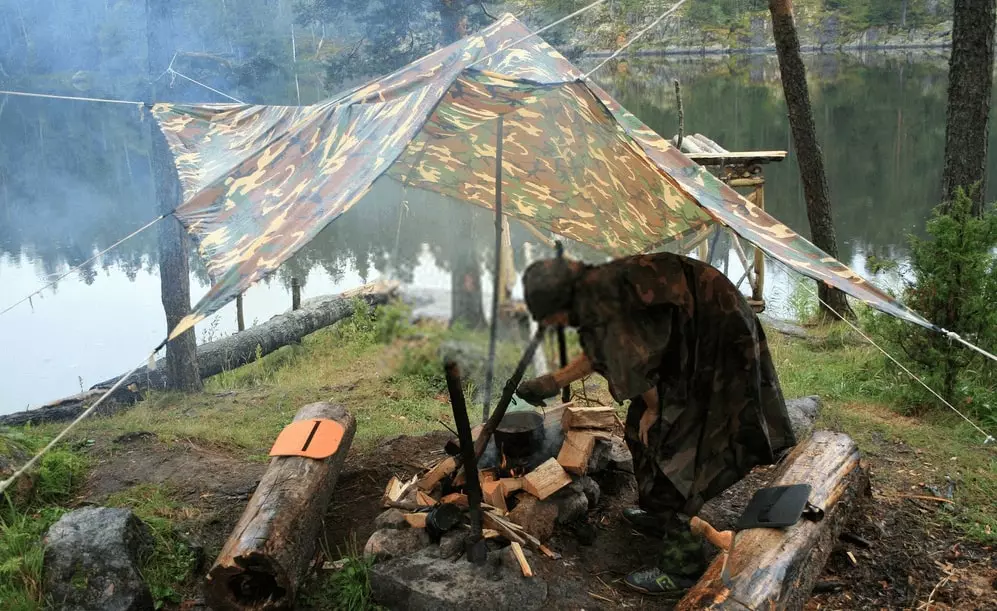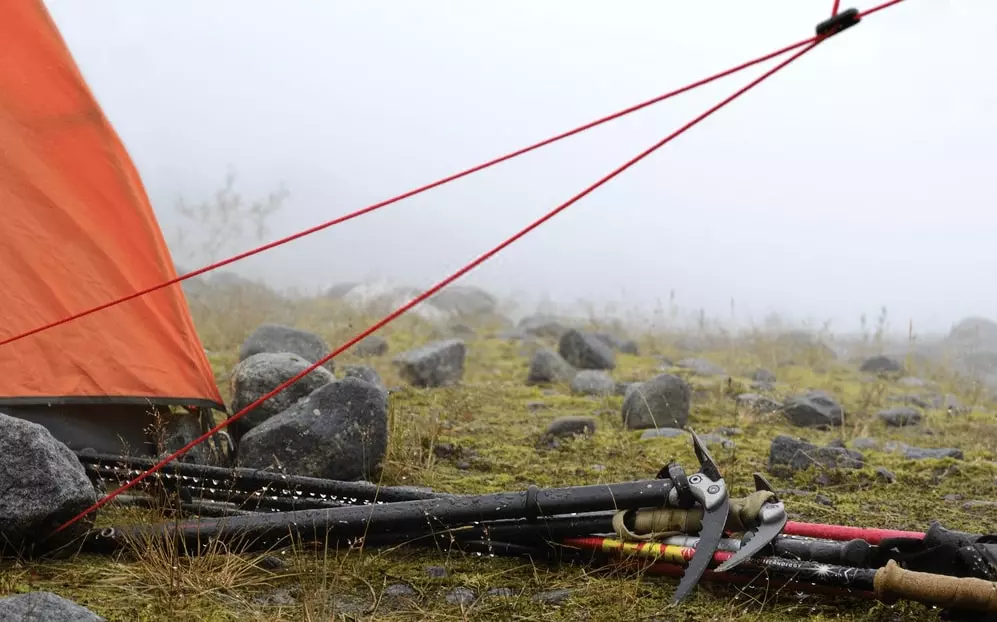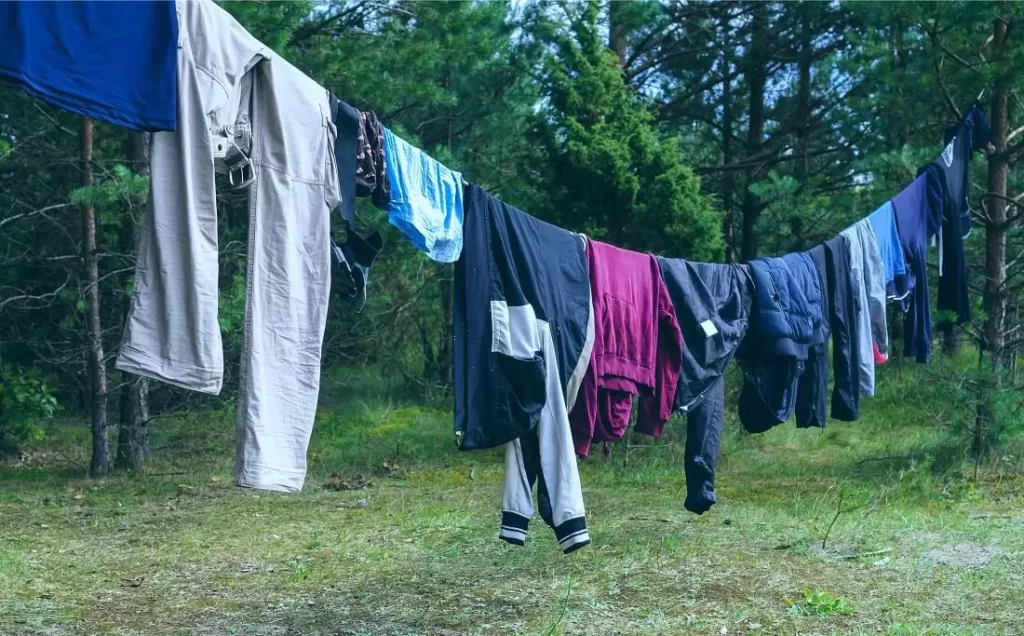Wet weather camping can be dreadful. However, if you find the right site, have the right gear, wear appropriate clothing, and follow some simple hacks, you can enjoy the experience.
The Great Smoky Mountains National Park receives about 11.4 million visitors yearly, making it the most visited park in the US and probably the world.
You’d be surprised to know that it records the highest annual rainfall in the region, approximately 58-60 inches.
Do people not worry about getting wet while camping or hiking in the Smokies?
While most of the precipitation in the area is in the form of fog, mist, and low-level clouds, many visitors still prepare thoroughly to deal with the damp and dull weather conditions.
This article will offer expert advice and simple hacks to enhance your overall experience during wet weather camping.

Table of Contents
1. Pitch Your Tent the Right Way
The first step to surviving rain is having proper shelter – an elevated, flat area where the ideal tent can be pitched.
It is important to choose a suitable terrain for camping or any outdoor activity.
Avoid camping in areas where water pools during rainfall, such as valleys.
Flat grounds can also lead to water pooling, so it’s best to find spots with a slight incline to prevent sleeping in a potential puddle of muddy water.
Avoid rivers, lakes, or other water bodies by camping at least 200 feet away.
It’s best to avoid standing directly under a tree during rainy weather, as the dripping water can be pretty bothersome.
Additionally, you’ll want to be careful of “widowmakers” or dead tree branches that may fall unexpectedly due to being soaked with water.
This can end your camping trip abruptly, so it’s essential to be aware of the potential danger.
Ensure the entrance points downhill to prevent sudden water, rain, or mud gushes from getting into your cozy tent as you sleep.
Setting up your tent facing the morning sun also earns you extra points.
I tuck my tent footprint edges under the tent to prevent water from pooling.
When it’s raining, the wind may become very aggressive, so protect your tent and tarp from being blown away or ripped apart by the grommets.
Place rocks on the corners to give your tent a solid base to give extra support while using guy lines.
As true Leave No Trace followers, we should always use well-worn campgrounds rather than build new ones to reduce our environmental impact.
Plus, they are good indicators of where it is safe to camp during rain.
Lighting is also essential when setting up camp.
Whether LED light strips, candles in mason jars, headlamps, lanterns, or reflectors, they will set the ambiance around your outdoor shelter and help you navigate the dark.
However, keep a closer eye on flames to avoid starting fires, and remember to bring extra batteries.
I charge everything before leaving for the campsite and carry a Jackery portable power source as a backup.
I have the Jackery 1500 and can personally attest to its reliability.
If you want to check out a smaller Jackery, please click the Amazon affiliate link. I love it!!!
Additionally, consider setting up an outdoor lounging or living area to reduce downtime during rains.
A tarp or two overhead, some camp chairs, music, snacks, and brew are enough to wait out the rain instead of retreating to the tents.
The lounge can also double up as a kitchen and dining area to cook meals.
Related Article: 6 Simple Steps to Effortlessly Set Up Your Tent: A Beginner’s Guide

2. Get the Right Gear for Wet Weather Camping
It’s important to use the appropriate gear correctly to stay dry and warm in bad weather while camping.
Wet weather camping can be challenging; you must carry extra gear to protect yourself from getting soaked.
After all, what’s the point of carrying additional weight if you end up soaking wet?
Tarps are the most effective and affordable way to waterproof your tent, while tent footprints are perfect for keeping groundwater out of your sleeping area.
Tyvek tarps are especially easy to recommend due to their waterproofing qualities and versatility.
Investing in an elevated sleeping system is highly effective for sudden downpours.
This can be achieved by staking items on which to lay your sleeping bag or by choosing more practical options like camping beds and cots.
Sleeping off the ground will help you stay dry and comfortable during your camping trip.
I sleep on a cot and a thin, inflatable pad. It is nice not to be on the ground during rainfall.
Related Article: Cot vs. Air Mattress for Camping: A Detailed Comparison to Help You Decide
Synthetic sleeping bags are good options as they have waterproofing properties and are much cheaper than down ones.
Just ensure you layer it up correctly for warmth and comfort.
In addition to carrying a matchbox or gas lighter, it is always a good idea to pack some traditional fire starters, such as concave/convex lenses, spark-based fire starters, and circuit shorting options.
These fire starters make it easier to build a campfire and help you quickly warm up.
Interestingly, duct tape cut into tiny pieces makes for good kindling, and cotton balls dipped in Vaseline (any petroleum product) perform even better.
If I am car camping, I’ll use a firestarter log to get the initial fire going. It may be cheating, but you will appreciate a quick fire in the rain.
Consider adding a bivy bag to your gear if the ground is cold and wet.
A bivy bag is specifically designed to help keep you warm by retaining body heat and protecting your sleeping bag from moisture.
However, breathing into the bag can reduce its effectiveness, so it is recommended that you keep your face exposed while using it.
In addition to having the proper equipment, it is vital to ensure that all your gear is in excellent condition.
A leaking tent can quickly ruin your camping adventure.
To avoid this, you should perform several tasks, such as sealing the tent seams, waterproofing your gear, inspecting the tarp or rain fly for holes, and checking for bent poles.
These measures will help you avoid unpleasant surprises and ensure an enjoyable and safe trip.
The waterproof membrane in tents and boots tends to wear off over time, so it needs to be replenished annually with suitable spray-on options to keep water and moisture at bay.
It is essential to remember that dirt can clog the waterproof membrane’s pores and restrict its breathability.

3. Wear Appropriate Clothing
The proper wear will keep the rain out and help keep you and your clothes dry.
A good-quality rain jacket, poncho, or raincoat should feature a hood, be sufficiently waterproof, have armpit vents, and be easily packable.
Backpacking rain ponchos can significantly enhance your camping experience, but many campers overlook their usefulness.
They can help you navigate wet trails under dripping trees and set up your tent during a rainy spell.
You might want to consider ultralight options that are easy to pack and don’t take up too much space in your backpack.
I keep a couple of rain ponchos packed in their pouches in my backpack. I have run into a few surprise showers while hiking.
Rain pants with drawstrings, an elastic waistband, or Velcro fasteners will protect you from the rain and make slipping on and off your boots easy.
Quick-to-dry synthetic shorts and T-shirts are also very welcome in wet conditions.
Gaiters with water-resistant uppers will add extra footwear and leg protection against snow, dirt, mud, pebbles, and vegetation.
They are also the best option for bushwalking in wet conditions.
They can be hot, so weigh your clothing options for staying dry.
Getting hiking boots instead of shoes is better, as boots offer better waterproofing abilities and help you quickly navigate wet terrain.
I wear waterproof sandals around the campsite and quickly remove my shoes when entering and exiting the tent.
Merino wool, polyester, and nylon are excellent materials for clothing in any weather condition.
On the other hand, cotton is not recommended as it tends to absorb moisture.
Wool clothing, in particular, is an excellent choice as it repels moisture, wicks sweat away, keeps you warm, and dries quickly.
Dress in Layers to Keep Warm
The base layer should be worn next to the skin to keep it dry by wicking away moisture.
It should be lightweight and quick-drying and made from polyester, Merino wool, polypropylene, silk, or polyester.
I prefer wearing athletic shirts that are moisture-wicking before adding other layers.
The middle layer is the insulating layer that retains body heat to protect you from the cold.
You can choose from thicker and naturally insulative materials such as polyester fleece, down-insulated jackets, and synthetic insulated coats.
The outermost layer that protects against rain and wind is the shell layer.
The DWR or Durable Water Repellant rating plays a crucial role, balancing breathability and water resistance.
That said, wearing bright colors like orange or red for visibility on humid, rainy days is also essential.
If you plan on car camping during rainy weather, you must prioritize packing compression dry bags.
These bags will dry your gear and clothing, even if they accidentally fall into the water.
Using a backpack rain cover will also help keep your gear dry during your camping trip.
4. Pack Foods That are Quick to Prepare
Humans need food to maintain body temperature in cold weather, so it’s essential to have pre-prepped and ready-to-eat meals and drinks.
Hot chocolate, cocoa, or even a steaming cup of coffee can be a great comfort during cold nights or afternoons.
It’s always a good idea to bring along some ready-to-eat food packs to avoid the need for extra gear and allow for quick fixes.
Chopping and peeling in the cold can be frustrating, so it’s best to be prepared.
Non-cooked foods come in four main types: raw, dehydrated, freeze-dried, and packaged ready-to-eat.
Whatever option you choose, check the nutrition information, if available, to balance your diet.
Some popular options include the following:
- Breakfast: canned beans, dried/fresh fruits, coffee, instant tea, instant hot cereals, pancake mix, granola bar, and dehydrated eggs
- Lunch: energy bars, bagels, fig bars, beef jerky, nuts, and dried fruit
- Dinner: ramen noodles, pasta, instant soups/sauces, instant rice, tuna, and packaged meals

5. Quickly Dry Wet Clothing
If your clothes become wet, it is advisable to dry them first to minimize the risk of mildew growth and loss of body heat.
It has been observed that staying dry is the most effective way to keep warm, and wet clothes can make it more difficult to maintain body temperature.
Hanging wet clothes when camping in the rain can be done using a portable clothesline, spreading them over a bush when it’s sunny, or hanging them securely off your backpack when moving.
If the rains are too heavy and your clothes are damp, there are several options for temporary storage.
You can use compressible organizers, resealable tubs, bins, or garbage bags.
A microfiber towel is an excellent option for drying off.
6. Wet Weather Camping Hacks
Nothing is more frustrating than starting your day by wearing cold, damp clothes.
However, you can avoid this unpleasant experience by preheating your clothes overnight.
To do this, put your clothes in a compressible organizer and place it under your sleeping bag.
In the morning, your clothes will be warm and cozy, ready to wear.
Non-electric boot dryers with silica oxide beads can help absorb moisture in your leather footwear.
Do you often wake up feeling thirsty in the middle of the night?
This could be a sign of dehydration, but finding your water bottle frozen would be even worse.
One great hack to avoid this is to flip your water bottle upside down before bed so the bottom freezes first.
Other equally effective methods include using insulated bottles, burying your water flasks, and putting the bottle into your sleeping bag.
Trail runners are a better footwear option for muddy and slippery trails because they are lightweight and dry quicker.
It’s worth considering them over hiking boots.
Your sleeping bag is the last thing you want to get wet, so keep it safe and dry at all costs. A dry bag or even a trash bag will be very helpful here.
7. Knowing When to Break Camp
Camping in the rain can be an enjoyable experience, but it is crucial to know when to pack up and leave.
Water is essential for life, but it can also be destructive in the form of hurricanes, tornadoes, flash floods, and tsunamis.
A NOAA (National Oceanic and Atmospheric Administration) weather radio should be part of your camping gear for weather updates and alerts.
I placed a link for a good NOAA radio option for your convenience. Amazon Affiliate Link.
Emergency Radio Raynic 5000 Weather Radio Solar Hand Crank
Flash Floods
Flash floods can occur shortly after a heavy downpour in areas that cannot soak up the water, such as low-lying areas, streams, and rivers.
The force of the flowing water is so powerful that just six inches of it can be enough to knock over a full-grown adult.
Flash floods have the potential to uproot trees, dislodge boulders, destroy buildings and bridges, and inundate banks.
If you find yourself in the midst of such an event, the first thing to do is to seek higher ground and avoid washes, canyons, valleys, dips, and low spots.
When crossing streams, remember to “Turn Around, Don’t Drown!”
Never hike near river beds in low-lying areas, and always look for warning signs.
Wet Trails
Be careful on the trails even after the rain stops.
Tread cautiously on slick-looking bare rocks and exercise extra caution on damp logs and moss-covered rocks.
Trekking poles are a helpful tool for maintaining balance and stability while hiking on slippery trails.
However, it’s important not to rely on them solely and to use your hands on the ground when necessary for additional support.
I started using trekking poles in the past few years. I can tell you they help with climbing, especially descending steep hills.
When crossing streams, it’s recommended that you undo the sternum straps and hip buckles of your backpack in case of emergencies.
This will enable you to ditch it if needed quickly.
Landslides
A landslide occurs when a large amount of debris, rocks, or earth moves down a slope.
You can recognize some of its signs, such as the presence of wet areas in places that are typically dry, the appearance of seeps and springs, abnormal bulges in the ground, an increase in turbidity, or unusual sounds like the noise of boulders hitting each other and trees snapping.
You should avoid hiking in areas with existing landslides, slopes, and drainage hollows.
Flat-lying terrains away from abrupt changes in inclination and at the top of ridges are relatively safe.
Also, familiarize yourself with the landslide preparedness safety tips as detailed at https://www.redcross.org/get–help/how-to-prepare-for-emergencies/types-of-emergencies/landslide.html.
Lightning
Lightning is one of the major causes of storm-related deaths in the US.
It accounts for 27 deaths of all reported in the last ten years, leaving survivors with varying degrees of disability.
Related Information: The National Weather Service-How Dangerous is Lightning?
Always plan your camping trip according to the weather forecasts.
Be cautious of the development of large storms; if you hear thunder, be aware that you are near a lightning bolt.
It’s best to avoid walking in open fields and areas with isolated trees.
Instead, choose forested areas for protection.
If you’re hiking with a group, avoid metal objects and try to walk a good distance apart.
Avoid fences and flag poles where possible, and always remember to drop your hiking poles.
Final Thoughts
When wet weather camping, you can enjoy quieter campgrounds, more opportunities to explore, and a renewed appreciation for nature’s sounds, smells, and serenity.
Finding the right spot, having the appropriate gear and clothing, and taking a few precautions will help you have an enjoyable camping experience in the rain.
With this newfound information, you can plan your camping trip without worrying about rain.
Enjoy living the outdoor life!!!
